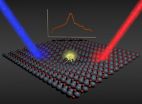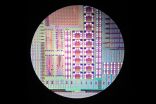Pseudoparticles travel through photoactive material
KIT scientists measure important process in the conversion of light energy -- publication in Nature Communications
2015-04-23
(Press-News.org) This news release is available in German.
Researchers of Karlsruhe Institute of Technology (KIT) have unveiled an important step in the conversion of light into storable energy: Together with scientists of the Fritz Haber Institute in Berlin and the Aalto University in Helsinki/Finland, they studied the formation of so-called polarons in zinc oxide. The pseudoparticles travel through the photoactive material until they are converted into electrical or chemical energy at an interface. Their findings that are of relevance to photovoltaics among others are now published in the renowned journal Nature Communications.
Processes converting light into storable energy may contribute decisively to a sustainable energy supply. For billions of years, nature has been using such processes for photosynthesis to form carbohydrates with the help of light. In research, phototcatalysis that uses light to accelerate chemical processes is gaining importance. In the past years, researchers also achieved considerable progress in photovoltaics converting incident sunlight directly into electrical energy. Efficiency constantly improved.
However, the processes underlying photovoltaics have hardly been studied in detail so far. "Conversion of photons, i.e. light particles, into electricity takes several steps," Professor Christof Wöll, Head of the Institute of Functional Interfaces (IFG) of KIT, explains. First, light is absorbed in a photoactive material. Single electrons are removed from their site and leave a hole there. The electron-hole pairs are stable for a short term only. Then, they either decay under the emission of light or are separated into an electron and a hole that move in the material independently of each other. The fate of this charged particle then depends on the material.
In most materials, free holes are not stable, but converted into so-called polarons under energy loss. A polaron is a special pseudoparticle composed of a particle and its interaction with the environment. The polarons formed are stable for a longer term and travel through the photoactive material until they are converted into electrical or chemical energy at an interface.
Researchers of KIT under the direction of Professor Christof Wöll have now carried out experiments using photoactive zinc oxide material in order to study the formation and migration of polarons. They employed a worldwide unique experimental setup for infrared reflection absorption spectroscopy (IRRAS) with a temporal resolution of 100 milliseconds and measured infrared spectra of zinc oxide monocrystals and observed intensive absorption bands, i.e. fingerprints, of a so far unknown pseudoparticle. Interpretation of the data and identification of this new particle were big challenges for the KIT scientists. In cooperation with a group working at the Fritz Haber Institute and the Excellence Center for Computational Nanoscience (COMP) of Aalto University, however, they succeeded in unambiguously allocating the absorption bands to so-called hole polarons. "This is an important finding made in 2015, the International Year of Light and Light-based Technologies," Professor Wöll says.
INFORMATION:
Hikmet Sezen, Honghui Shang, Fabian Bebensee, Chengwu Yang, Maria Buchholz, Alexei Nefedov, Stefan Heissler, Christian Carbogno, Matthias Scheffler, Patrick Rinke, and Christof Wöll: Evidence for photogenerated intermediate hole polarons in ZnO. Nature Communications, 22nd April 2015. DOI 10.1038/ncomms7901.
Karlsruhe Institute of Technology (KIT) is a public corporation pursuing the tasks of a Baden-Wuerttemberg state university and of a national research center of the Helmholtz Association. The KIT mission combines the three core tasks of research, higher education, and innovation. With about 9,400 employees and 24,500 students, KIT is one of the big institutions of research and higher education in natural sciences and engineering in Europe.
Since 2010, the KIT has been certified as a family-friendly university.
This press release is available on the internet at http://www.kit.edu.
The photo of printing quality may be downloaded under http://www.kit.edu or requested by mail to presse@kit.edu or phone +49 721 608-4 7414. The photo may be used in the context given above exclusively.
[Attachments] See images for this press release:

ELSE PRESS RELEASES FROM THIS DATE:
2015-04-23
A Spanish-led team of European researchers at the University of Cambridge has created an electronic device so accurate that it can detect the charge of a single electron in less than one microsecond. It has been dubbed the 'gate sensor' and could be applied in quantum computers of the future to read information stored in the charge or spin of a single electron.
In the same Cambridge laboratory in the United Kingdom where the British physicist J.J. Thomson discovered the electron in 1897, European scientists have just developed a new ultra-sensitive electrical-charge sensor ...
2015-04-23
How long is the way from the city hall to the train station? When we estimate distances, something curious happens: short distances seem longer, and long distances shorter than they really are. Similar biases occur during judgments of volume, brightness or time. Psychologists call this phenomenon Vierordt's law. Its independence of the involved sensory systems suggests that our brain possesses universal principles for the assessment of physical quantities. However, where do the characteristic estimation biases stem from? In collaboration with colleagues from Zurich, neuroscientists ...
2015-04-23
It's a common dilemma faced by many working parents: your child has a cough or a cold, do you send them to nursery?
Researchers from the University of Bristol have, for the first time, investigated the process of decision-making that parents go through when faced with this situation. The research, published in The Journal of Public Health, reports that parents viewed coughs and colds as less serious and not as contagious as sickness and diarrhoea symptoms.
This resulted in many parents sending their child to daycare with a respiratory tract infection (RTI), which can ...
2015-04-23
In response to an article published by Chinese scientists describing research that used gene editing technologies in human embryos, the International Society for Stem Cell Research (ISSCR) has again called for a moratorium on attempts at human clinical germline genome editing while extensive scientific analysis of the potential risks is conducted, along with broad public discussion of the societal and ethical implications. The research article, entitled "CRISPR/Cas9-mediated Gene Editing in Human Tripronuclear Zygotes," was published online on April 18 in the scientific ...
2015-04-23
Imagine a day when scientists are able to alter the DNA of organisms in the lab in the search for answers to a host of questions. Or imagine a day when doctors treat genetic disorders by administering drugs designed to alter a patient's genome.
It may sound like science fiction, but with the development of genome-editing proteins like Cas9 and CRISPR, it could one day become science fact.
Before that happens, however, scientists must overcome a number of challenges, including how to improve the specificity of these proteins- the rate at which genome-editing proteins ...
2015-04-23
A more intellectually demanding job may be the key to living longer after developing young-onset dementia, according to health researchers.
Degeneration of the frontal and temporal parts of the brain leads to a common form of dementia affecting people under the age of 65. It results in changes in personality and behavior and problems with language, but does not affect memory.
"[Our] study suggests that having a higher occupational level protects the brain from some of the effects of this disease, allowing people to live longer after developing the disease," said Lauren ...
2015-04-23
An international team of scientists is calling for urgent and temperature patterns in mountain regions after compiling evidence that high elevations could be warming faster than previously thought.
Without substantially better information, people risk underestimating the severity of a number of already looming environmental challenges, including water shortages and the possible extinction of some alpine flora and fauna, according to the research team, which includes Henry Diaz and Imtiaz Rangwala from CIRES, the Cooperative Institute for Research in Environmental Sciences ...
2015-04-23
Shetland ponies' immune response to insect bites is helping scientists understand how people could be prevented from developing allergies.
The horse immune system can respond to midge bites in a way that prevents - rather than triggers - allergic reactions, researchers say.
The ponies' immune response to midge bites is similar to what happens in people with allergies, the team says. Understanding what triggers allergic reactions could help researchers come up with ways to stop people developing sensitivities.
It was previously thought that ponies which do not suffer ...
2015-04-23
April 23, 2015, Vienna, Austria: A drug approved to treat type 2 diabetes could prove to be a powerful new treatment option for non-alcoholic steatohepatitis (NASH), according to research presented today at The International Liver CongressTM 2015. Results from a randomised controlled trial showed liraglutide met the primary endpoint of histological clearance of NASH, and a reduction in the progression of fibrosis. The research was supported by the Wellcome Trust and the NIHR.
In the Liraglutide Efficacy and Action in NASH (LEAN) trial, overweight patients with biopsy-confirmed ...
2015-04-23
April 23, 2015, Vienna, Austria: Phase III results revealed today at The International Liver Congress™ 2015 show that once-daily treatment with daclatasvir (DCV) plus sofosbuvir (SOF) resulted in an overall 97% sustained virologic response (SVR) at 12 weeks post-treatment in patients with hepatitis C virus (HCV) and HIV co-infection, including cirrhotic patients.
HIV co-infection more than triples the risk of hepatitis C-related liver disease, liver failure and liver-related death. Co-infection can also complicate the management of HIV infection.
In the ALLY-2 ...
LAST 30 PRESS RELEASES:
[Press-News.org] Pseudoparticles travel through photoactive material
KIT scientists measure important process in the conversion of light energy -- publication in Nature Communications



